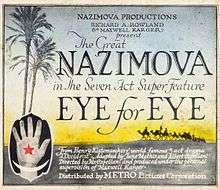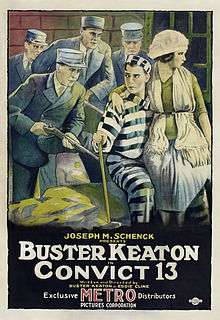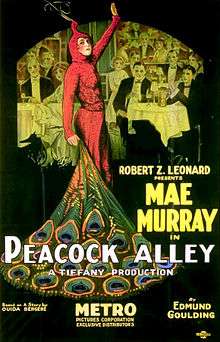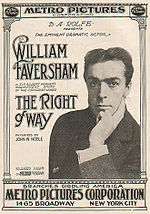Metro Pictures
| Industry | Film studio |
|---|---|
| Fate | Merged with Goldwyn Pictures and Louis B. Mayer Pictures |
| Successor | Metro-Goldwyn-Mayer |
| Founded | June 23, 1915 |
| Defunct | April 17, 1924 (Metro-Goldwyn-Mayer merger) |
| Headquarters | Heidelberg Building, New York City |
Key people |
Richard A. Rowland (President) Louis B. Mayer (secretary) |
Metro Pictures Corporation was a former American motion picture production company founded in early 1915 and was a forerunner of Metro-Goldwyn-Mayer.
The company produced its films in either New York or Los Angeles and some times at leased facilities in Fort Lee, NJ.[1]
History






Metro Pictures founded a film distribution company in February 1915 by a number of "exchange men" with Richard A. Rowland as president, George Grombacker as vice-president and Louis B. Mayer as secretary. Grombacker owned exchanges in Portland and Seattle. Rowland and Metro's 2nd vice president James B. Clark were from the Roland & Clark company based in Pittsburgh. Metro was capitalized with $300,000 in cash and founded for the purpose of controlling movie productions for the exchanges.[2] Rowland had been an investor in Alco Film Corp. which was a distribution company for a coalition of productions companies. Mayers convinced Rowland to set up Metro to replace Alco as to avoid being picked up by Paramount, Mutual Film or Universal. Metro had Rolfe Photoplays, Inc. and Popular Plays and Players moving over from Alco to Metro. Additional production companies working with Metro were Columbia (1915-1917; not the current Columbia, CBC Sales until 1918), Quality Picture Corporation and Dreyda.[3]
In 1915, Metro established its back lot in Hollywood on N. Cahuenga Boulevard between Willoughby Avenue and Waring Avenue bound by Lillian Way on the east.[4] Metro's first release on March 29, 1915 was "Satan Sanderson" film produced by Rolfe Photoplays which was originally to be distributed by Alco Film Company.[5] "Sealed Valley" was Metro's first production released on August 2, 1915.[6] Mayer left to form his own production unit in 1918.[7]
In 1919, the company was purchased by Marcus Loew as a supplier of product for his theater chain. However, Loew was not satisfied with the amount or quality of Metro's output. A few years later in 1924, Loew merged it with his recently acquired Goldwyn Pictures and shortly Louis B. Mayer Productions then renamed the new entity Metro-Goldwyn-Mayer in 1925 with Mayer in charge.[8]
Stars
Metro's biggest stars during the World War I period were the romantic teams of Francis X. Bushman and Beverly Bayne and Harold Lockwood and May Allison. Also in top echelons of importance were actresses Mae Murray and Viola Dana and from the stage Lionel and Ethel Barrymore, Emmy Wehlen and Emily Stevens. Before merging into MGM in 1924, Metro's star roster had expanded to include Lillian Gish, Buster Keaton, Jackie Coogan, Marion Davies, Ramon Novarro, Wallace Beery and Lewis Stone.
Motion Picture Studios
Although the Metro film library and stars were merged into MGM in 1924, Rowland's Los Angeles film studio continued a life of its own. It was known simply as Motion Picture Studios through the 1940s, General Service Studios and Desilu Studios through the 1950s and 1960s. It became Ren-Mar Studios in 1974. In January 2010, Ren-Mar Studios was bought by Red Digital Cinema Camera Company. The complex was renamed "Red Studios – Hollywood" It is located on Cahuenga Blvd. north of Melrose Avenue in Hollywood (directly behind the Musicians AFM Local 47 on Vine Street).
David E. Kelley filmed several of his TV series there, including Picket Fences, Ally McBeal, and The Practice.
Filmography
A 1967 fire in a MGM Archive #7 storage facility destroyed over negatives and prints, including the best-quality copies of every Metro pictures and Louis B. Mayer Picture produced prior until 1924; over half of MGM's feature films from before 1930 are completely lost.
- Filmed in Fort Lee, NJ
- The Eternal Question (1916) Olga Petrova
- The Divorceé (1919) Ethel Barrymore
- What People Will Say? (1915) directed by Alice Guy Blache[1]
- Sealed Valley (1915) Dorothy Donnelly[6]
References
- 1 2 "Studios and Films". Fort Lee Films.org. Fort Lee Film Commission. Retrieved December 20, 2014.
- ↑ "The Metro Corporation", Motography, XIII (8): 278, February 20, 1915, retrieved December 5, 2013
- ↑ McMahan, Alison (August 22, 2014). Alice Guy Blaché: Lost Visionary of the Cinema. Bloomsbury Publishing USA. p. 179. Retrieved December 22, 2014.
- ↑ Monush, Barry; Sheridan, James (June 1, 2011). Lucille Ball FAQ: Everything Left to Know About America's Favorite Redhead. Applause Theatre & Cinema. Retrieved December 22, 2014.
- ↑ "Satan Sanderson". AFI Catalog of Feature Films. American Film Institute. Retrieved December 22, 2014.
- 1 2 "Sealed Valley". AFI Catalog of Feature Films. American Film Institute. Retrieved December 22, 2014.
- ↑ "Louis B. Mayer". The Biography.com. A&E Television Networks. Retrieved December 22, 2014.
- ↑ International Directory of Company Histories. Vol. 25. St. James Press. 1999. Retrieved December 20, 2014.
External links
| Wikimedia Commons has media related to Metro Pictures. |
- AFI Catalog
- Metro Pictures Corporation distribution
- Metro Pictures Corporation production
- Metro Pictures Corporation at the Internet Movie Database
- Metro Pictures Corporation at Silent Era